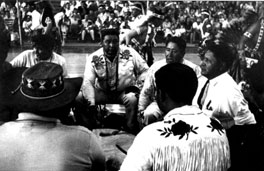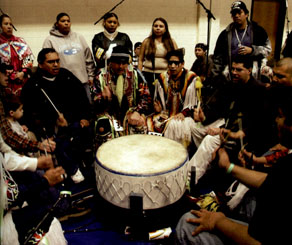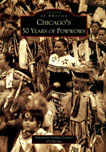|

 |
Chicago's Fifty Years of Powwows |
<Adapted from the book of the same name>
The Second Circle: The Men at the Drum
The Drum (a powwow term that conveys the group of singers) is at the center of the arena and the center of attention. The big powwow Drum is made from a wooden (or sometimes metal) shell covered in rawhide. Today, cowhide is common, although buffalo, horse, steer, or moose hide is sometimes used.
Songs are composed for many reasons and exist for the people. Songs from Indian country, have a direct relation to the oral tradition. These songs have power and when sung "in a good way" we allow the environment an opportunity to receive the good. The environment (the land and the people who derive from it) is the ultimate receiver of the good. Without the land where would we be?
Today, there are two kinds of songs, word songs and vocable songs. Word songs are generally the older songs because Native languages were widely spoken. On the other hand, vocable songs are composed regularly due to the growing absence of language and the formation of intertribal communities. Vocables are melodic sounds used in place of language and words.
Follow this link to learn more about each type of song performed at powwows and to hear some examples.
Forward to the next page of this essay Back to the previous page of this essay Back to the menu page for this essay Listen to some Powwow Songs Back to Online Essays
|
| |
Department
of Anthropology |
copyright ©
2002 University of Illinois, All rights reserved. |




